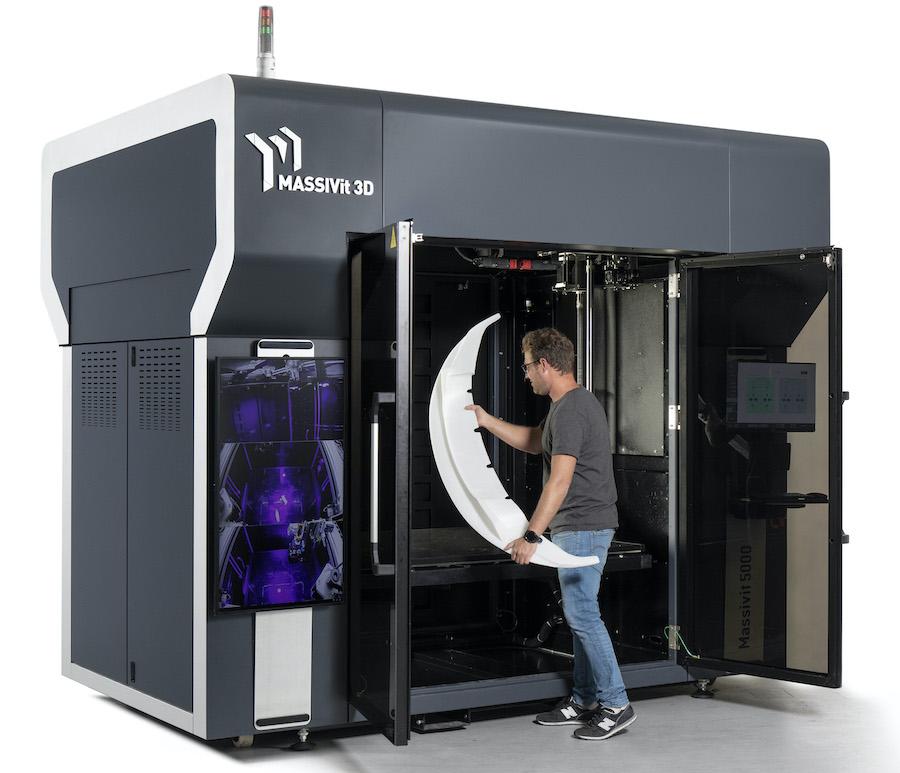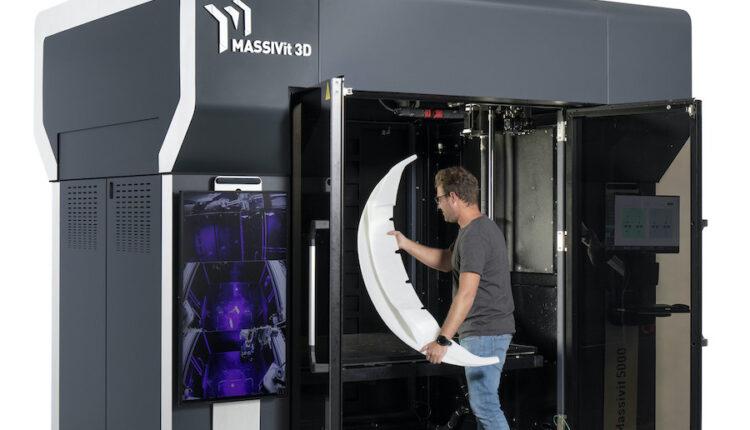
Israeli 3D printer manufacturer Massivit 3D has launched a new machine that’s specifically designed to reduce the time it takes to produce large-format composite molds.
Powered by the firm’s Cast-In-Motion (CIM) technology, the Massivit 10000 enables users to create intricate tooling in a rapid four-step gel dispensing and casting process, which simplifies the molding workflow. In doing so, the system unlocks higher throughputs and reduced tooling iteration cycles for adopters, particularly those operating in the automotive, aerospace, energy and marine sectors.
“We are thrilled to unveil our advanced Cast-In-Motion technology to the composite manufacturing arena,” Massivit 3D CEO Erez Zimerman said at the CAMX 2021 expo. “This market is hungry for innovation that will shift the paradigm for molding so that manufacturers can finally expedite their lead times from several weeks down to just a few days.”
Large-format Gel Dispensing Printing
Founded in 2013, Massivit specializes in the production of large-format machines for clients in the engineering, academic, architecture and visual communications markets. Each of the firm’s systems are built around its proprietary Gel Dispensing Printing (GDP) technology, an approach that’s basically a cross between FFF and material jetting, in which gels are extruded at high speed and cured into layers.
Available in normal and ‘Pro’ iterations, Massivit’s flagship 3D printer, the 1800 Series, is a 145cm x 111cm x 180cm machine that’s capable of creating super-sized models and molds at a pace up to 30 times quicker than traditional technologies. Over the years, this scalability has allowed the systems to address varying applications, including the creation of thermoforming molds and huge advertising displays.
Building on the success of its 1800 3D printer, the company opted to launch a new machine in April 2021: the Massivit 5000. Designed to meet the needs of providers producing large photopolymer parts for automotive, marine and railway customers, the unit features a unique Dual Material System, that enables two parts to be 3D printed simultaneously with different materials and levels of resolution if desired.
To support its growing portfolio of printers, the firm has also released two new materials, including the flame-retardent Dimengel 20-FR as well as the translucent design verification and architecture-oriented UL94-V0, and following its IPO earlier this year which saw it raise $50 million, it has now continued to expand on its offering with the Massivit 10000.
Putting the ‘massiv’ into Massivit

Launched at the CAMX 2021 expo, the colossal 1.2 x 15 x 1.65-meter 10000 3D printer is built to address what Massivit sees as the pain points of creating large composite parts: cost, lead time and complexity. Largely, the machine is able to combat these thanks to its built-in CIM technology, which condenses a normal 19-step molding workflow into a four-stage process, by eliminating the need for an initial ‘plug.’
In place of a traditional master design, the CIM process begins instead with users creating a desired tooling pattern out of UV-curable gel, which can then be 3D printed from various thermoset engineering materials. Once printed, these parts are immersed in water where their patterned sacrificial material is allowed to break away, leaving a mold that when cured and polished, is end-use ready immediately.
According to Massivit, this approach yields “improved accuracy, consistency and higher reliability” parts, while being less wasteful than the tools traditionally used to create large composite builds. The firm also says the Massivit 10000 is 80% quicker and requires 90% less labour to operate than normal part design machinery, making it a “disruptive mold-making solution” that “shifts the tooling paradigm.”
“By automating the mold production process, we’re able to offer manufacturers a way to dramatically cut their costs and reduce the associated material waste,” Zimerman added. “The snowballing demand for this digital molding solution is testament to the dire need for this technological milestone, and we are excited to offer it to the CAMX community in the lead up to the Massivit 10000 launch.”
3D printing formidably-sized molds
Outside industrial manufacturing circles, molds may seem like a low-key part of the production process, but their accuracy and durability can be key to the success or failure of their end-products. To improve the speed, scale and sustainability with which these molds can be produced, multiple commercial and academically-funded projects have now been commissioned into 3D printing them instead.
In one such initiative, the Thermwood Corporation partnered with aviation firm Bell to 3D print a 20-foot helicopter blade mold. Believed to be the largest autoclave capable-tool of its kind ever made, the temperature and elevation pressure-resistant equipment is specifically designed to be used in the shaping and development of robust chopper parts.
Elsewhere, on a more experimental level, researchers at ETH Zurich have sought to address similar architectural applications to those of Massivit, by creating a prototype metal facade using 3D printed sand molds. Composed of 26 individual pieces and standing 3.5 meters tall, the ‘Deep Facade’ design was ultimately built from large-scale molded aluminum parts.
To stay up to date with the latest 3D printing news, don’t forget to subscribe to the 3D Printing Industry newsletter or follow us on Twitter or liking our page on Facebook.
For a deeper dive into additive manufacturing, you can now subscribe to our Youtube channel, featuring discussion, debriefs, and shots of 3D printing in-action.
Are you looking for a job in the additive manufacturing industry? Visit 3D Printing Jobs for a selection of roles in the industry.
Featured image shows an automotive bucket seat mold 3D printed using the new Massivit 10000 3D printer. Image via Massivit 3D.